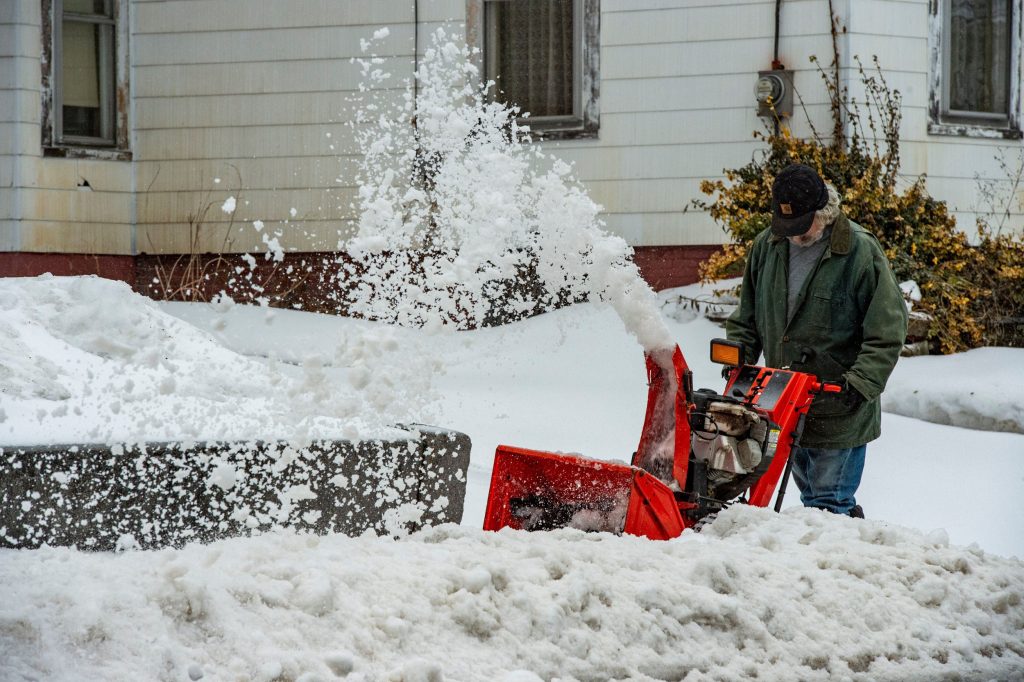A widespread winter storm system is impacting a large swathe of the United States, bringing heavy snow, freezing rain, and strong winds to 13 states. The National Weather Service (NWS) has issued a combination of winter storm warnings and advisories, urging residents to prepare for hazardous travel conditions and potential power outages. The storm is expected to continue through Wednesday, leaving significant snow accumulations and icy conditions in its wake. The affected states include Alaska, South Dakota, Wyoming, New Mexico, Colorado, Maine, Wisconsin, New York, Vermont, Michigan, Massachusetts, Montana, and New Hampshire.
The most severe conditions, warranting winter storm warnings, are anticipated in parts of Alaska, South Dakota, and Wyoming. The Black Hills region, spanning South Dakota and Wyoming, is forecast to receive between 3 and 9 inches of snow, with higher accumulations possible in elevated areas. Strong winds gusting up to 30 mph will further exacerbate travel difficulties. In Alaska, the Interior Seward Peninsula and Middle Yukon Valley are bracing for heavy snow, potentially topped with a layer of ice, coupled with winds gusting up to 40 mph, creating potentially impossible travel conditions. The NWS has stressed the importance of carrying emergency supplies, including a flashlight, food, and water, for those who must travel during the storm.
Beyond the areas under winter storm warnings, a broader range of locations are under winter weather advisories, indicating less severe but still hazardous conditions. In Alaska, Kivalina, Red Dog Dock, the Lower Kobuk Valley, and the Baldwin Peninsula are anticipating a mix of precipitation, including freezing rain, snow, and blowing snow, with winds gusting up to 50 mph, significantly reducing visibility. Montana’s Bears Paw Mountains, Southern Blaine, and the Snowy and Judith Mountains are also expected to receive accumulating snow.
Across the Northeast, several states are facing a mix of snow, sleet, and freezing rain. Massachusetts has issued advisories for several counties, including Northern Worcester, Northern Middlesex, Western Franklin, Western Hampshire, and Northern Berkshire. Maine is anticipating a transition from snow to mixed precipitation and then to freezing rain, affecting areas including south central and southwest Maine, as well as central, northern, and southern New Hampshire. Coastal regions of Maine, including Hancock, Washington, and Aroostook counties, are also under advisories. Vermont’s Bennington and Windham counties are expecting snow and sleet transitioning to freezing rain, potentially resulting in light ice accumulations. In New York, northern portions of Warren, Hamilton, Fulton, and Herkimer counties are under a snow and sleet advisory.
The Midwest and Southwest are also experiencing impacts from the storm system. Wisconsin’s Iron County and the city of Hurley are under a winter weather advisory, with up to 10 inches of snow possible in northern Iron County. Michigan’s Gogebic County is under an advisory for slippery road conditions, with potential for heavier snow and reduced visibility later Tuesday through Wednesday. In New Mexico, the Johnson and Bartlett Mesas, including the Raton Pass, are expecting a light dusting to one inch of snow. Colorado’s Wet Mountain Valley, Northern Sangre de Cristo Mountains, and areas around Trinidad and Walsenburg are also under advisories for slick and hazardous road conditions due to snowfall.
This expansive winter storm underscores the importance of staying informed about local weather conditions and heeding the advice of local authorities. The NWS continues to monitor the storm’s progress and update forecasts and advisories as needed. Residents in affected areas should prepare for potential travel disruptions, power outages, and challenging weather conditions. It is crucial to avoid unnecessary travel and to have emergency supplies on hand in case of prolonged power outages or road closures. Regularly checking local weather reports and following safety guidelines issued by authorities are essential for navigating this widespread winter weather event.
The broad geographic reach of this storm system, spanning from Alaska to the Northeast and encompassing the Midwest and Southwest, highlights the dynamic nature of winter weather patterns. The varying impacts, from heavy snow accumulations in some areas to freezing rain and icy conditions in others, necessitate specific preparations based on local forecasts. The potential for hazardous travel conditions across numerous states underscores the need for caution and preparedness, particularly for those who must travel during the storm.
The NWS continues to emphasize the importance of staying informed about changing weather conditions. Updates to forecasts and advisories are issued regularly, and residents are encouraged to monitor these updates through local news outlets, weather apps, and the NWS website. Staying informed enables individuals to make informed decisions about travel plans and other activities, minimizing the risks associated with winter weather hazards.
Preparing for potential power outages is also crucial, especially in areas expecting heavy snow or ice accumulation. Having emergency supplies on hand, including flashlights, batteries, non-perishable food, and water, can ensure basic needs are met during an outage. It is also advisable to have a plan for staying warm, such as using a fireplace or wood stove if available, and to check on neighbors, especially elderly or vulnerable individuals, during periods of severe weather.
This widespread winter storm serves as a reminder of the importance of winter weather preparedness. Having a plan in place, staying informed about weather conditions, and taking necessary precautions can help mitigate the risks associated with winter storms and ensure safety throughout the season. The coordinated efforts of the NWS and local authorities provide valuable resources for individuals and communities to navigate the challenges posed by winter weather events.










